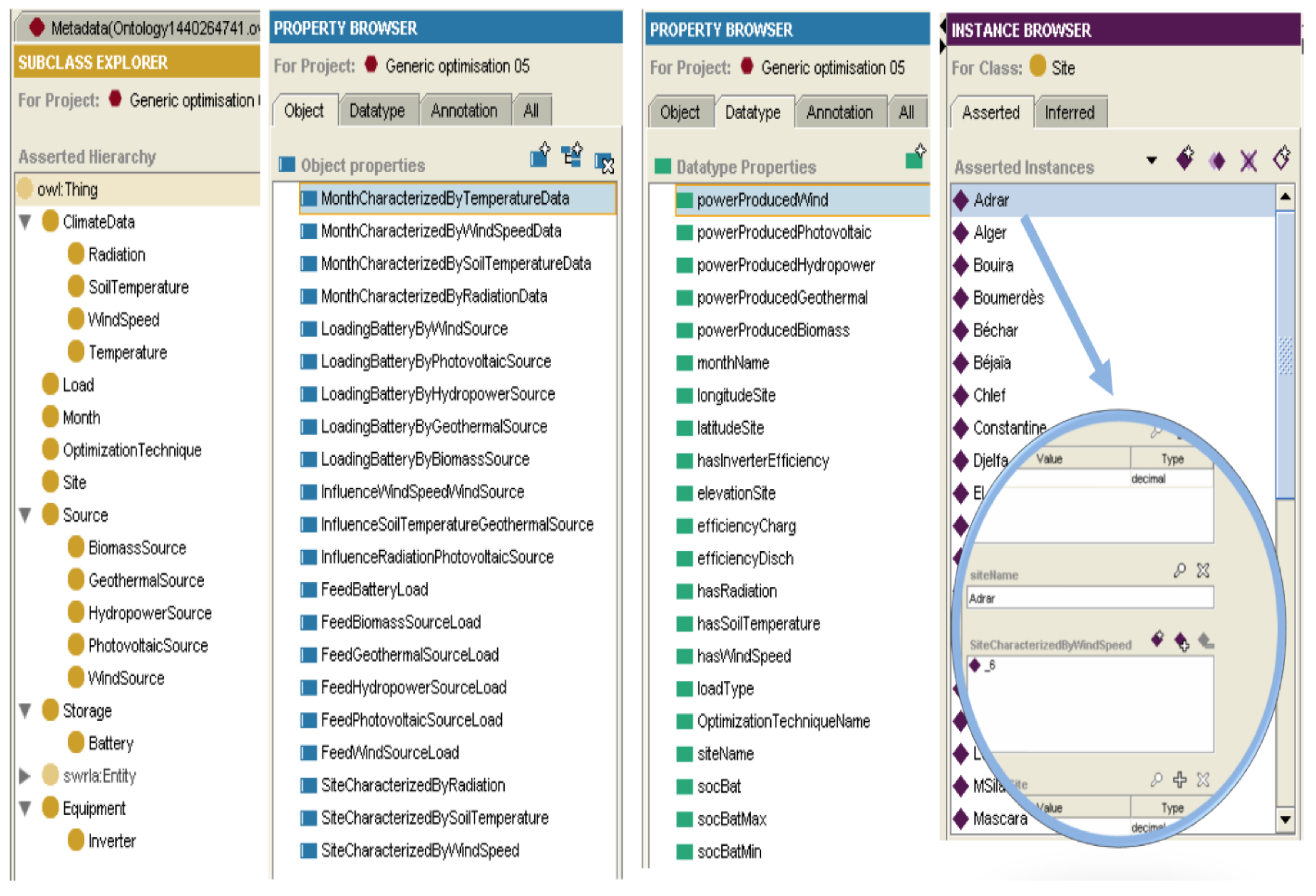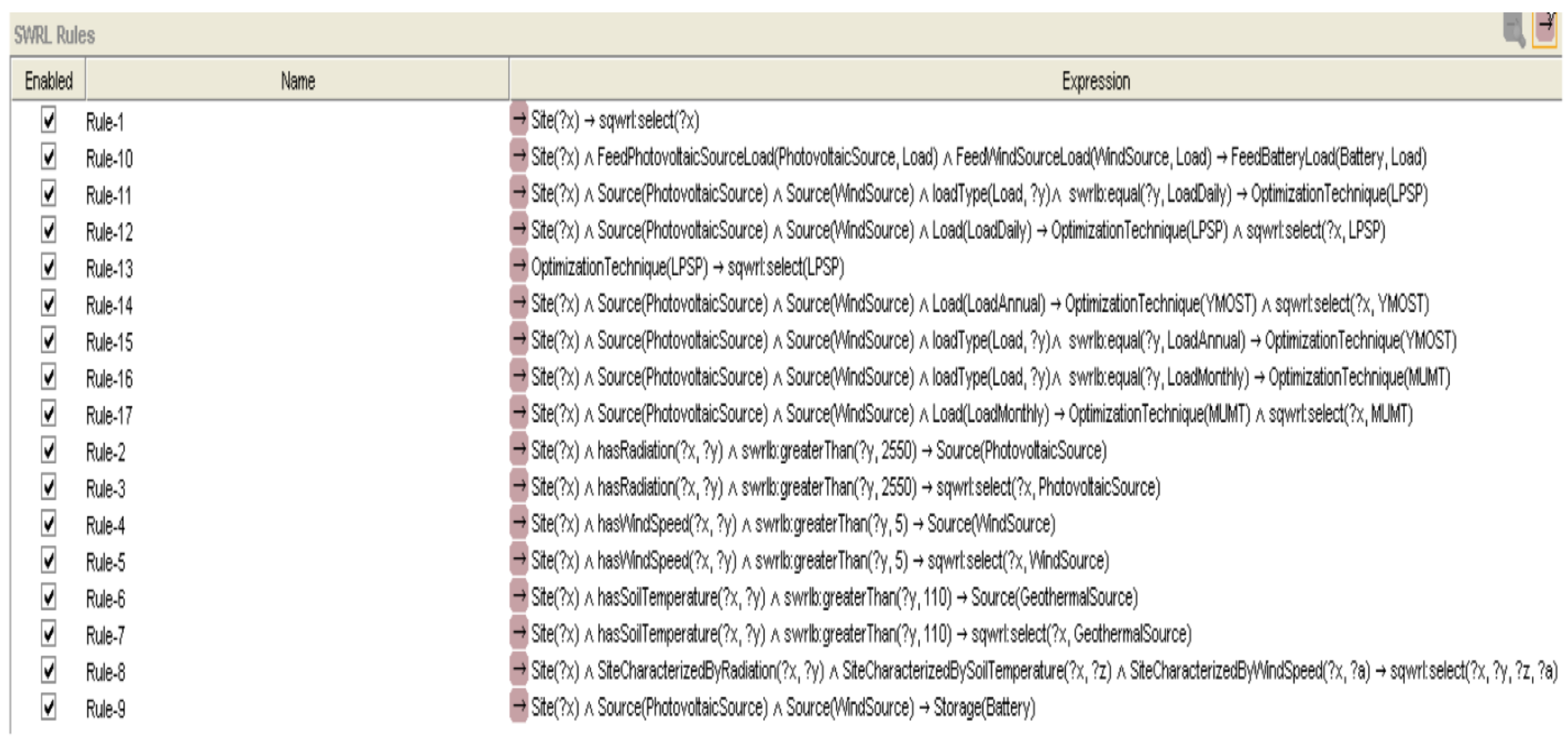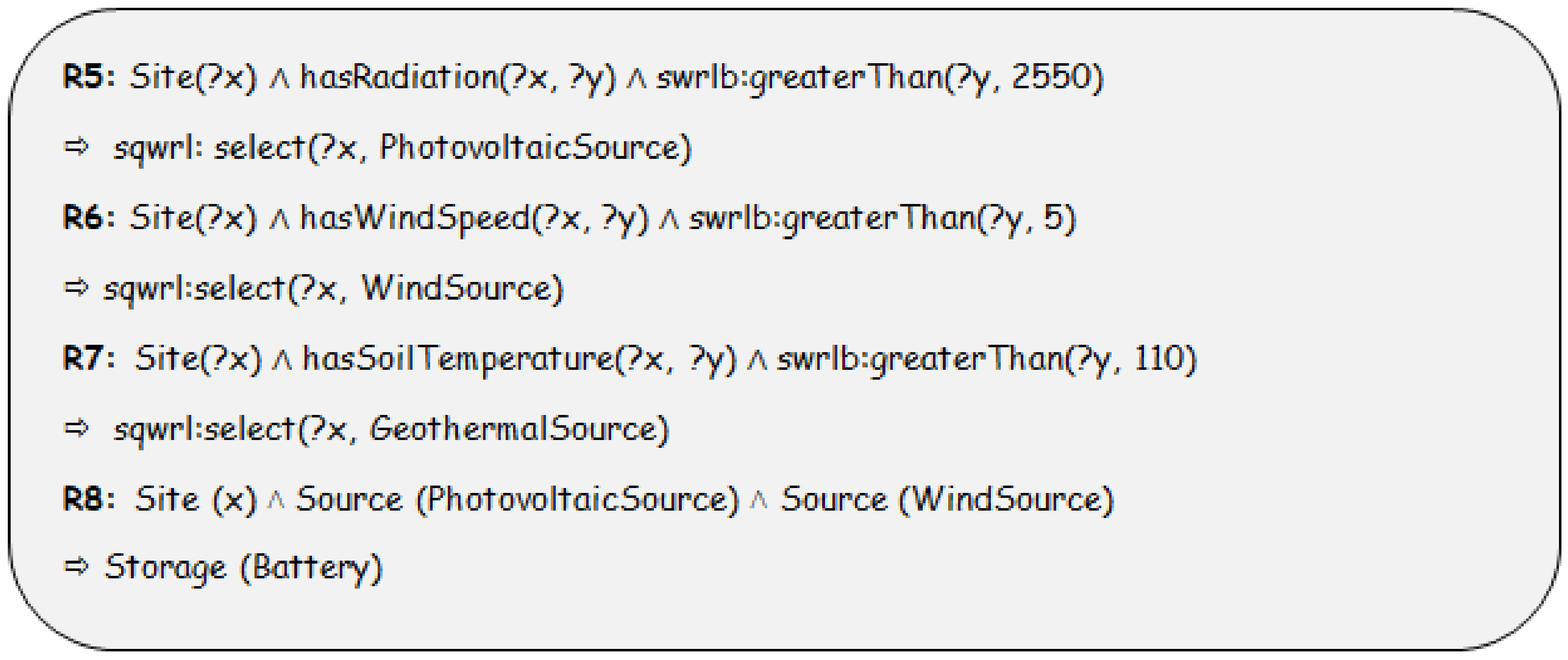1. Introduction
Air pollution, climate change, and limited fossil resources have raised awareness that sustainable development that takes care of the environment in which we live is necessary [
1]. With the difficulty of connecting electricity grids to remote areas, RE presents a good alternative to fossil fuels, it does not emit greenhouse gases, and it allows the decentralized production of resources [
2]. However, the random specificity of energy sources imposes special rules for the optimization and operation of energy systems. In addition, the hybridization between some of the RE sources forms a complementarity of energy production and an alternative to conventional generators generally used to produce electricity. An HES design is an important step because of its relationship to completion costs and reliability [
3]. Therefore, it is necessary to provide new solutions and focus in particular on meeting consumer demands for energy while ensuring the minimum cost [
4].
To meet the rapidly increasing demand for energy, all energy sources must be exploited. Renewable energies are unlimited and clean, but the biggest problem with them lies in their intermittent aspect. To overcome this problem, a combination of several energy sources is made to obtain the so-called hybrid renewable energy system [
5,
6]. Many works have been carried out on HES optimization methodologies. A study by Ammari et al. aimed at presenting and analyzing a literature review of recently published works in the field of hybrid renewable energy [
7]. The study focuses on four basic categories of hybrid renewable energy systems, which are scaling (using software or using conventional methods), optimization (classical, synthetic, and hybrid methods), control (centralized, distributed, and hybrid control), and energy management (technical and economic objective). Furthermore, the review compares the different methods used in each category. A research work by Nourollahi et al. presents a hybrid approach to process improvement and addresses uncertainties in a residential energy system consisting of photovoltaics, fuel cells, boilers, and storage units [
8]. In this regard, uncertain parameters are divided into two categories, including poorly behaved and well-behaved parameters, and then robust optimization and stochastic programming are used for modeling. Additionally, the conditional value at risk is implemented to assess the risks of well-behaved parameters. According to simulations, it has been shown that uncertainties with bad behavior have greater effects on the operation of the system. Moreover, changing the control parameters for robust optimization and conditional value at risk from 0 to 24 and from 0 to 1 increases the total cost by 5.2% and 0.47%, respectively. Comparative results also show that the proposed hybrid method makes less conservative decisions for cost optimization. The application of hybrid energy storage to distributed energy systems can greatly improve energy efficiency and reduce operating costs. However, insufficient efforts focused on investigating the integration of the two systems, configuration optimization, and systems operation strategy were found. Therefore, a new distributed energy system that combines hybrid energy storage was proposed, and the configuration of the system optimization and the operation strategy of the new system were considered simultaneously [
9]. The studied hybrid system contained thermal storage and two forms of energy storage, that is, supercapacitors and a lithium battery. The impact of hybrid energy storage on distributed energy systems was fully considered. Then, a two-layer cooperative optimization method for the new system was introduced, taking into account energy efficiency, economy, and environmental protection. The new system was applied to an almost energy-free society. The results indicate that the energy-saving and equivalent pollutant-equivalent primary emission reduction rates for the new system were evaluated to be 54.8% and 63.6%, respectively, under the low-pass filter operating strategy combined with secondary feedback modulation of the supercapacitor charge state. System configuration and operating strategy can be optimized simultaneously by the two-layer collaborative optimization method. Renewable energy resources often suffer from challenges, such as erratic energy generation, as a consequence of weather and seasonal changes. Hybrid renewable energy systems are a solution for efficient energy densification of renewable resources as several of them are combined to overcome challenges arising from operating them in a stand-alone mode. A study by Sharma et al. proposed multitarget dynamic optimization of candidate hybrid renewable energy systems using a genetic algorithm in which the operating cost of hybrid renewable energy systems, nonrenewable energy use, and fuel emissions were simultaneously reduced over a limited period [
10]. In optimization, three strategies are evaluated by considering the profiles of wind, solar, and 24 h load (Strategy 1), past and 1 h ahead (Strategy 2), and 1 h ahead (Strategy 3). A comparison of the results shows that the energy to be purchased from the network for Strategy 1 is 8.7% and 10.7% lower compared with Strategies 2 and 3, and also the energy sold to the network is 19% and 22% higher than for Strategies 2 and 3, respectively, while meeting the specified load profile of 100 households.
One of the most important applications of the renewable energy system is installing a well-designed HES in remote areas where grid extension is complicated and expensive. However, the proper design of such a system is a difficult task, such as coordination between different energy sources. Energy storage and load are very complex. Hybrid renewable energy system optimization is selecting appropriate components, scaling, and control strategies to provide efficient, reliable, and cost-effective alternative energy to society. A work by Fulzele and Daigavane presents a design of a hybrid renewable energy system consisting of photovoltaic cells and a wind generator with a battery and an inverter [
11]. The system was optimally simulated using the HOGA (Hybrid Optimization by Genetic Algorithms) tool developed by the Department of Electrical Engineering of the University of Zaragoza, Spain. In the same context, a work by Mahmoud et al. is concerned with the application of modern optimization methods to devote the optimal configuration of hybrid renewable energy sources, which include photovoltaic panels, wind turbines with battery storage systems, and diesel generators [
12]. The cost function of the optimization problem was chosen to be the energy cost and energy supply potential loss for the hybrid renewable energy system, where the main function of the optimization algorithms is to reduce this cost function. However, the optimal configuration cannot be achieved without meeting system reliability and operational limitations. A comparison of their results was made in order to determine the most effective method. Furthermore, a statistical study was conducted to determine the stability of the performance of each optimization strategy. The results revealed optimal variables, including the number of photovoltaic panels, wind turbines, batteries, and diesel generator capacity. Over the course of a year, the optimal configuration was tested against the study of capital and fuel expenditures. The statistical results also proved the robustness of the developed algorithm. Cano et al. presented a comparative study between four optimization methods for autonomous HES, which include two energy sources (PV, wind), storage batteries, and fuel cells [
13]. The first method is based on mathematical equations, the second uses the SDO program, the third uses the Homer optimization software, and the last uses genetic algorithms based on the HOGA software. The results show that the HES designed by each method guarantees reliability in the energy supply, and SDO is the best HES optimization method. Other contributions use AI approaches. Maleki and Askarzadeh propose four heuristic algorithms, PSO, TS, SA, and HS, on an autonomous HES (PV, wind turbine, fuel cell) [
14]. This study showed that HES with energy storage batteries is the best choice economically, and PSO is the most reliable optimization technique. In the same context, Aydin et al. were interested in the development of a methodology based on the information of a GIS to identify the preferred sites for an HES based on wind and PV [
15]. This study used the principle of fuzzy logic and the MCDM approach to determine the economic feasibility of wind and solar energy. Finally, the associated maps were superimposed to obtain the most feasible places for HES. The proposed methodology can help policymakers and investors easily adapt to other types of energy resources. Luna-Rubio et al. provided an overview of optimization methods. The study presented the different architectures of stand-alone or network-connected HES [
16]. This study concluded with the following submissions:
HES that includes solar and wind energy sources requires the addition of storage batteries or integration into the grid.
Among the methods proposed (probabilistic, analytical, iterative, and hybrid), the hybrid methods are the most powerful for HES optimizing.
Djamel Saba et al. provided an optimization solution for HES based on the intelligent reasoning rules [
17,
18]. Then, this solution was improved to be generic. After implementing it, the results showed its effectiveness in choosing the optimization technique. In addition, it is characterized by various advantages, such as flexibility in its operation and updating [
19]. Coelho et al. proposed a MAS solution to optimize the HES [
20]. Amicarelli et al. proposed to minimize the costs, maximize the use of RE, and simplify the integration into the grid [
21]. Elamine et al. present an intelligent method of HES energy management [
22]. The solution is based on the MAS. This concept allows the different units of the MAS to work together to achieve the objectives. Morstyn et al. studied the performance of the control strategy by verification on a microgrid that includes storage batteries and a PV generator [
23]. This study allows us to know the advantages that characterize distributed management compared with centralized management. L. Raju et al. developed a MAS for managing the energy of a microgrid containing two PV systems, two wind turbines, a battery unit, and a diesel plant [
24]. This solution offers the consumer the possibility of choosing the actions to increase energy efficiency. A study adapted to the west African climate was conducted by Mbodji et al. It is based on the MAS for the control, where it was applied on an HES (PV, wind, batteries) [
25]. In this study, three load profiles were considered in the simulations. Then, the control made it possible to reduce battery use by 3%, 5%, and 6%, for profiles 1, 2, and 3, respectively. It was made in 1 day to obtain 35 kWh for profile 1 and 20 kWh for profile 3. From an economic aspect, the strategy applied to profile 1 was allowed a gain of EUR 6 per day and EUR 2322 per year or more than EUR 46,442 for 20 years (lifetime of the project).
The present study is intended to face the problem of the absence of a generic optimization solution for hybrid energy systems. The main objective of this work is to set up a reliable and easy solution to optimize hybrid energy systems suitable for most sites (generic). For these reasons, this study proposes a generic optimization solution. With this solution, the user is not required to know much data about optimization techniques, energy sources, and climatic data. The user only chooses the installation site, and it is up to the adopted solution that provides the appropriate sources as well as the most reliable technique to calculate the optimal configuration of the system to be installed. This contribution is based on the ontology of the field of energies. The choice of ontology is mainly due to the nature of the studied system and its environment (energy system), which is dynamic over time. In addition, this technique makes it possible to precisely present a set of knowledge in a form that can be permitted for use by a machine, which allows users to introduce the necessary updates without occurrence of any damage to the rest of the data.
4. Conclusions
This work focused on the problem of optimizing HES. In this context, it was proposed to develop an optimal solution based on ontology.
The HES are systems that combine multiple energy sources to meet electricity needs. They allow improvements in terms of energy efficiency and increasing integration of RE sources. However, the process of optimizing these systems is complex, especially with its distributed and interactive nature with the external environment.
In an HES, energy sources and storage tools are combined to meet consumer demand for electricity while ensuring the lowest cost. These tasks are the main goals for HES optimization. However, because of the intermittent nature of RE, the optimization of the HES is difficult, which depends principally on the data of energy sources and climate. Responding to the optimization problem is precisely the objective of this work.
There is a set of tools for HES optimization, such as algorithms and software, where each is based on one or hybridization between several approaches (probability, linear programming, fuzzy logic, neural networks, etc.). There is also some software for HES optimization, the most popular being Hybrid, TRNSYS [
38], Hybrid2, Homer [
39], and HOGA [
40]. However, the choice between these tools is considered a real problem. First, a generic optimization solution for HES was developed. This contribution shows its reliability following an explanatory scenario and based on real data from Algerian sites. The results indicate the importance of the proposed solution for real uses, where the user can benefit from many advantages, such as saving time, accuracy, and ease of use.
For future works, this solution needs collaborative work with experts in many fields, which will allow the development of the existing solution in many points, as well as the introduction of some other technologies, such as multiagent systems, especially the mobile agent, which can navigate to the source of information to take it instead of staying in a fixed address and communicate with the rest of the agents based on network protocols, which makes the solution more effective. Finally, extensive testing must be performed for other case studies to find the limits of the use of this solution.














